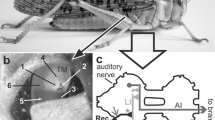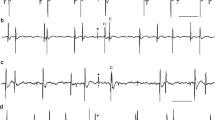Summary
-
1.
At the preferred body temperature of the locust (30 °C and above), the metathoracic fast extensor of the tibia (FETi) motorneuron will sometimes spike in response to synaptic input from the descending movement detector (DMD) visual interneurons. This does not occur at lower temperatures (Fig. 1). The mechanism of the change in excitability is investigated in FETi and other identified motorneurons over the range 18–35 °C.
-
2.
Action potentials show a reversible decrease in amplitude and duration on heating (Fig. 2).
-
3.
EPSP amplitudes are relatively unchanged by temperature, but their duration decreases slightly on heating (Fig. 3).
-
4.
Membrane potential hyperpolarises on heating and depolarises on cooling (Fig. 4).
-
5.
Membrane resistance shows a transient increase on cooling, and a transient decrease on heating (Fig. 10), but there is usually little steady-state change in resistance with temperature (Fig. 5).
-
6.
Spike threshold shows a transient increase followed by a steady-state decrease on heating, and the opposite on cooling (Fig. 10). This can be demonstrated with injected current (Fig. 6), membrane depolarisation (Fig. 7), spontaneous spike frequency (Fig. 9), and naturally occurring EPSPs (Fig. 8). This change in spike threshold is regarded as the major neural correlate of the change in excitability with temperature.
Similar content being viewed by others
References
Baust, J.G.: Temperature-induced neural adaptations: motoneuron discharge in the Alaskan beetlePterostichus brevicornis (Carabidae). Comp. Biochem. Physiol.41 A, 205–213 (1972)
Bernard, J., Gahery, Y., Boistel, J.: The effects of temperature changes applied to the cercal nerves and to the sixth abdominal ganglion of the cockroach (Blabera craniifer Burm.) In: The physiology of the insect central nervous system (eds. J.E. Treherne, J.W.L. Beament), pp. 67–72. London and New York: Academic Press 1965
Boistel, J.: Caractéristiques fonctionnelles des fibres nerveuses et des récepteurs tactiles et olfactifs des insectes. Paris: Librarie Arnette 1960
Burkhardt, D.: Die Erregungsvorgänge sensibler Ganglienzellen in Abhängigkeit von der Temperatur. Biol. Zbl.78, 22–62 (1959)
Burrows, M.: The morphology of an elevator and a depressor motoneuron of the hind wing of a locust. J. comp. Physiol.83, 165–178 (1973)
Burrows, M.: Monosynaptic connections between wing stretch receptors and flight motoneurones of the locust. J. exp. Biol.62, 189–219 (1975a)
Burrows, M.: Co-ordinating interneurons of the locust which convey two patterns of motor commands: their connexions with ventilatory motoneurones. J. exp. Biol.63, 735–753 (1975b)
Burrows, M., Horridge, G.A.: The organization of inputs to motoneurones of the locust metathoracic leg. Phil. Trans. B269, 49–94 (1974)
Burrows, M., Hoyle, G.: Neural mechanisms underlying behaviour in the locustSchistocerca gregaria. III. Topography of limb motoneurones in the metathoracic ganglion. J. Neurobiol.4, 169–186 (1973)
Burrows, M., Rowell, C.H.F.: Connections between descending visual interneurones and metathoracic motoneurones in the locust. J. comp. Physiol.85, 221–234 (1973)
Burrows, M., Siegler, M.V.S.: Transmission without spikes between locust interneurones and motoneurones. Nature (Lond.)262, 222–224 (1976)
Crossman, A.R., Kerkut, G.A., Pitman, R.M., Walker, R.J.: Electrically excitable nerve cell bodies in the central ganglion of two insect species,Periplaneta americana andSchistocerca gregaria. Investigation of cell geometry and morphology by intracellular dye injection. Comp. Biochem. Physiol.40 A, 579–596 (1971)
Goldman, L., Hahin, R., Begenisch, T.: Sodium flux, action potential and temperature dependence. Nature (Lond.)257, 516–517 (1975)
Goodman, C.S., Heitler, W.J.: Isogenic locusts and genetic variability in the effects of temperature on neuronal threshold. J. comp. Physiol.117, 183–207 (1977)
Guttman, R.: Effect of temperature on the potential and current thresholds of axon membrane. J. gen. Physiol.46, 257–266 (1962)
Heitler, W.J., Burrows, M.: The locust jump: II. Neural circuits of the motor programme. J. exp. Biol.66, 221–241 (1977)
Hodgkin, A.L., Huxley, A.F.: The dual effect of membrane potential on sodium conductance in the giant axon ofLoligo. J. Physiol. (Lond.)116, 497–506 (1952)
Hodgkin, A.L., Katz, B.: The effect of temperature on the electrical activity of the giant axon of the squid. J. Physiol. (Lond.)109, 240–249 (1949)
Hoyle, G.: A function for neurons (DUM) neurosecretory on skeletal muscle of insects. J. exp. Zool.189, 401–406 (1974)
Hoyle, G., Burrows, M.: Neural mechanisms underlying behaviour in the locustSchistocerca gregaria. I. Physiology of identified motoneurons in the metathoracic ganglion. J. Neurobiol.4, 43–67 (1973)
Hoyle, G., O'Shea, M.: Intrinsic rhythmic contractions in insect skeletal muscle. J. exp. Zool.189, 407–412 (1974)
Huxley, A.F.: Ion movements during nerve activity. Ann. N.Y. Acad. Sci.81, 221–246 (1959)
Katz, B., Miledi, R.: The release of acetylcholine from nerve endings by graded electrical pulses. Proc. roy. Soc. B167, 23–38 (1967)
Kerkut, G.A., Taylor, B.J.R.: The effect of temperature changes on the activity of poikilotherms. Behaviour13, 259–289 (1958)
Marchiafava, P.L.: The effect of temperature change on membrane potential and conductance inAplysia giant nerve cell. Comp. Biochem. Physiol.34, 847–852 (1970)
Mellanby, K.: Low temperature and insect activity. Proc. roy. Soc. B127, 473–489 (1939)
Merickel, M., Kater, S.B.: Neuronal change: compensatory acclimation of the contribution of an electrogenic pump to the resting potential. J. comp. Physiol.94, 195–206 (1974)
Murray, R.W.: The effect of temperature on the membrane properties of neurons in the visceral ganglion ofAplysia. Comp. Biochem. Physiol.18, 291–303 (1966)
Nicolls, J.G., Purves, D.: A comparison of chemical and electrical synaptic transmission between single sensory cells and a motoneurone in the central nervous system of the leech. J. Physiol. (Lond.)225, 637–656 (1972)
Pearson, K.G., Fourtner, C.R.: Nonspiking interneurons in walking system of the cockroach. J. Neurophysiol.38, 33–52 (1975)
Pierau, F.-K., Klee, M.R., Klussmann, F.W.: Effects of local hypo- and hyperthermia on mammalian spinal motoneurones. Fed. Proc.28, 1006–1010 (1969)
Rowell, C.H.F.: The orthopteran descending movement detector (DMD) neurons: a characterisation and review. Z. vergl. Physiol.73, 167–194 (1971)
Schauf, C.L.: Temperature dependence of the ionic current kinetics ofMyxicola giant axons. J. Physiol. (Lond.)235, 197–205 (1973)
Strelnikov, I.D.: On the question of heat production of insects in relation to movement and sunshine. Bull. Inst. Sci. Leshaft19, 243–255 (1935) (in Russian)
Strelnikov, I.D.: The effect of solar radiation and microclimate upon body temperature and behaviour of larvae ofLocusta migratoria. L. Trav. Inst. Zool. Acad. Sci. URSS2, 637–733 (1936) (in Russian)
Usherwood, P.N.R., Grundfest, H.: Peripheral inhibition in skeletal muscle of insects. J. Neurophysiol.28, 497–518 (1965)
Uvarov, B.: Grasshoppers and Locusts: a handbook of general acridology, Vol. I. Cambridge: Cambridge University Press 1966
Author information
Authors and Affiliations
Additional information
This research was supported by USPHS grant NS 09404 to C.H.F.R. We are happy to be able to thank Dr. K.G. Pearson for his contribution to the initial discussions which led to this work, and Dr. M.R. O'Shea who suggested to us the use of the DUM neurons.
Rights and permissions
About this article
Cite this article
Heitler, W.J., Goodman, C.S. & Rowell, C.H.F. The effects of temperature on the threshold of identified neurons in the locust. J. Comp. Physiol. 117, 163–182 (1977). https://doi.org/10.1007/BF00612785
Received:
Issue Date:
DOI: https://doi.org/10.1007/BF00612785




